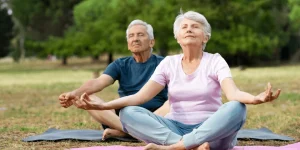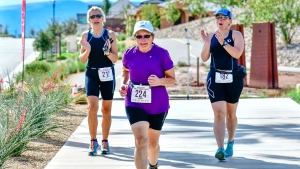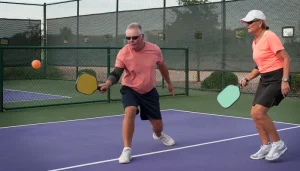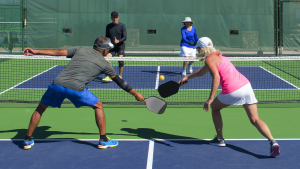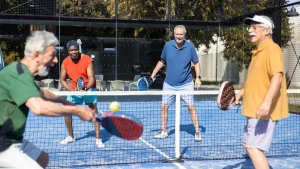6
Section One: The Fundamentals
A) Keywords
Exercise 1:
Provide a brief definition of one of the padlet keywords for this week.
| The “Anti-Aging Agenda” refers to the societal and cultural emphasis on preventing or reversing the physical signs of aging, often driven by consumerism, beauty standards, and the pharmaceutical industry. This agenda promotes the idea that aging is something to be feared or avoided, leading to an obsession with maintaining youthfulness through products, treatments, and lifestyle choices. It can also influence how older individuals are perceived and treated in society.
|
B) The Social Significance of Aging in Sport
Exercise 2: Notebook Prompt
How is old age popularly represented today? Find an image online that you think exemplifies one defining attitude towards old age and paste in your notebook below with a brief explanation of what this image means to you.
| Old age is often represented in popular media today in a variety of ways, ranging from images of vibrant, active seniors to more traditional depictions of frailty and dependence. One common representation, particularly in advertisements for anti-aging products and wellness, is that of older adults who defy traditional expectations by remaining physically active and youthful in appearance. These portrayals often focus on seniors who engage in activities like jogging, traveling, or practicing yoga, suggesting that age is no longer a barrier to living a fulfilling life. This narrative promotes the idea of aging as something that can be controlled or reversed, which aligns with the cultural obsession with youth and vitality.
In contrast, another prevalent representation is the idea of old age as a period of decline, with a focus on physical fragility, memory loss, and dependence on others. This portrayal can be seen in advertisements for healthcare products, senior living facilities, and medical devices, often highlighting the need for assistance or care. Such depictions contribute to the stereotype of aging as a process of deterioration, evoking feelings of fear or inevitability about growing older. An example of an image that embodies these contrasting ideas is one often seen in anti-aging campaigns, showing a well-dressed, older woman running on the beach or engaging in an activity that requires physical strength. To me, this image symbolizes the “anti-aging” agenda, which promotes the idea that old age can and should be fought against through fitness and appearance. While this representation highlights the agency of older adults, it also suggests that aging should be actively resisted, positioning those who age without physical prowess or beauty as somehow failing. This reinforces the notion that youthfulness, energy, and physical appearance are the ultimate markers of value in a person, regardless of age.
|
Exercise 3: Notebook Prompt
What does the article (referencing another study by Dionigi) mean by its statement that sport can help aging people to simultaneously “accept and resist the ageing process” (572)? Respond by audio or text and find paste two images sourced online into your notebook showing how sport might help aging people to both accept and resist the aging process.
| The statement that sport helps aging people to both “accept and resist the aging process” means that physical activity allows older adults to embrace their aging bodies while also challenging society’s expectations of aging. Sport helps individuals accept aging by adapting activities to fit their physical changes, acknowledging limitations, and staying active. But it also helps them resist aging by proving they can remain strong, competitive, and energetic, defying the idea that older adults must slow down or decline. In this way, sport helps aging people maintain independence and vitality, while reshaping how we think about aging.
|
Exercise 4: Notebook Prompt
Who are the groups less likely to have extensive opportunities to take part in sports, according to Pike? How does privilege factor into aging and sport? (200 words max)
| According to Pike, groups less likely to have extensive opportunities to participate in sports include marginalized communities such as those facing economic hardship, people with disabilities, women, and older adults. These groups often face systemic barriers that limit access to sports, such as a lack of resources, facilities, or social support.
Privilege plays a significant role in aging and sport, as individuals with more financial resources or social status are more likely to have access to quality facilities, personal trainers, and even time for recreational activities. In contrast, those who experience marginalization may struggle to find opportunities to engage in physical activities due to financial constraints or a lack of inclusive sports programs. Additionally, older adults with fewer resources might not have the means to participate in sports that require specialized equipment or memberships, which further limits their opportunities for physical activity. Overall, privilege can create disparities in access to sport, making it more challenging for certain groups, especially those marginalized by age, gender, and economic status, to fully embrace sports as a tool for health, enjoyment, and social engagement.
|
Exercise 5: Padlet Discussion
Why do you think age discrimination is “reported more than any form of prejudice” with older people presented as a threat to social values and interests? Feel welcome to use video in your responses. Paste your comments (or transcript of your video) below!
| Age discrimination tends to be reported more than other types of prejudice because older people are often seen as challenging the way society values youth and progress. In a world that prizes productivity, beauty, and innovation, aging is often linked to decline or obsolescence. This is reinforced by media, advertising, and even policies that focus on youth as the ideal and dismiss older adults as less capable or less relevant. Older individuals are sometimes viewed as a threat to social values because they disrupt the narrative that society is always moving forward. Youth are seen as the future, while older people are often left out of conversations about progress. This creates a perception that older adults have nothing to contribute, even though their experience and knowledge can be incredibly valuable. At the same time, stereotypes about aging, like the idea that older people are dependent or unable to keep up with change, play a big role in age discrimination. These stereotypes make it hard for older individuals to be recognized as active, engaged members of society. As a result, age discrimination is widespread, and older people are often pushed to the sidelines, excluded from discussions about societal growth and change.
|
B) Older Women and Sport
Exercise 6: Notebook Prompt
What differences do you see in these ads? Which one is more inclusive? How is age represented or not represented in each? Answer these questions in your notebook.
| The two ads, Nike-You Can’t Stop Us (2020) and This Girl Can-Me Again, differ significantly in their representation of age and inclusivity. The Nike ad showcases a wide range of athletes from various sports, emphasizing resilience, strength, and unity. However, it predominantly highlights younger athletes, with only brief glimpses of older individuals. While the ad promotes gender and racial inclusivity, it doesn’t prioritize age diversity, making it less inclusive in terms of representing older people. In contrast, This Girl Can – “Me Again” focuses on women of different ages, particularly celebrating women who return to fitness after a break, such as those who are older or have had children. This ad is more inclusive because it directly challenges age-related stereotypes, showcasing that sport is for everyone, regardless of age. It highlights the experience of older women engaging in physical activity, which is often underrepresented in media. Overall, This Girl Can is more inclusive in terms of age representation, making it a stronger advocate for the idea that fitness and sports are accessible to women at every stage of life.
|
Exercise 7: Notebook Prompt
In her article, “Assessing the sociology of sport: On age and ability,” Elizabeth Pike references a “trend towards a ‘feminisation of ageing’, with many women living longer than men” (573). Do you agree that aging has been “feminized” in this way? How? Answer these questions in your notebook.
| Yes, I agree that aging has been “feminized” in the way Elizabeth Pike suggests, particularly due to the fact that women generally live longer than men. This trend shapes how aging is perceived, represented, and discussed in society, often in ways that are distinctively gendered.
One way aging is feminized is through media representation. Older women are often depicted in terms of their appearance and beauty, with a significant focus on maintaining youthfulness. This is seen in the widespread marketing of anti-aging products and wellness routines, which are typically targeted at women. The media tends to emphasize women’s need to fight aging, often portraying older women as struggling to maintain physical appearance, while older men are depicted as aging “gracefully” or as embodying wisdom and dignity. This difference in representation reinforces the idea that women’s value is linked to their appearance, making aging a more scrutinized process for women than for men. Moreover, the health and wellness industries often cater specifically to older women, emphasizing fitness, beauty, and maintaining vitality as a way to resist the inevitable effects of aging. These industries focus on a market where women are expected to prolong their youthfulness and remain active and attractive. On the other hand, older men aren’t subjected to the same degree of societal pressure to “fight” aging through physical appearance, reinforcing the feminization of aging. Finally, societal expectations add another layer to the feminization of aging. Older women are often expected to maintain their independence and vitality through fitness and beauty, which positions aging as a challenge they need to overcome in order to remain relevant. Older men, conversely, may not face the same level of scrutiny about their physical appearance or vitality, and their aging process is more often linked to experience and wisdom rather than appearance. In conclusion, aging for women is more complex and heavily scrutinized, with societal pressures around beauty, health, and appearance, which are not as intensely applied to men. This trend reinforces the feminization of aging, as women are expected to maintain certain standards while aging that men are not.
|
Section Three: Module Mini Assignment
| In the article “Is a park still a park if it’s paved?” by Elaine Anselmi, the author explores a contentious plan to convert a green space in Peterborough, Ontario, into a facility with 16 pickleball courts, parking, and additional recreational spaces. While pickleball, a sport increasingly popular among older adults, is being promoted as a community-building, health-focused activity, the proposal has sparked heated debates. Critics argue that the replacement of green, natural park space with hard surfaces for pickleball and parking reflects a troubling shift in how parks are understood and used, with potentially negative environmental and social consequences.
In analyzing how older pickleball athletes and advocates are represented in media discussions, ageism subtly emerges. Many portray these players as part of a growing trend of “active aging,” where older adults are expected to maintain their physical vitality and health through participation in activities like pickleball. This portrayal reinforces the neoliberal notion that aging individuals should strive to remain productive and engaged to avoid being seen as burdens. The media coverage surrounding this issue often emphasizes the benefits of sports like pickleball for older adults, framing their participation as a positive and necessary form of resistance against the stereotypical view of aging as a time of decline and passivity. However, this also reflects a form of ageism, as it suggests that older adults should prove their worth by staying active and participating in trendy sports rather than allowing them to simply enjoy passive leisure or the freedom to engage in a range of activities that suit their preferences. From a neoliberal perspective, the debate around pickleball in Peterborough highlights the idea that aging adults should maintain health and independence through physical activity. The media coverage of the pickleball expansion aligns with this agenda, framing it as a solution to the problem of aging bodies while simultaneously sidelining concerns about environmental degradation and the loss of green space. This narrative echoes Pike’s discussion of aging and ability, where older adults are encouraged to resist the aging process through participation in sport to maintain their social value.
These images of older pickleball players engaging in energetic matches or promotional campaigns emphasize active aging reinforce this idea of aging as something to be resisted through athleticism, rather than embracing the full range of possibilities for older adults.
|


